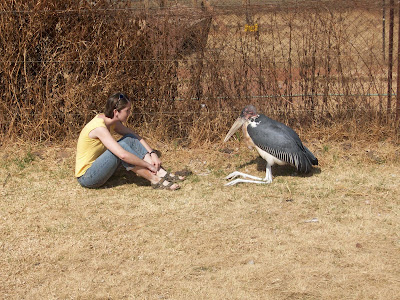My week in South Africa went by in a blur of conference lectures, swanky meet and greets, and a few amazing tours. One night, our group got all dressed up for a gala, then realized we didn't actually have tickets to it. But looking on the bright side, that gave us an All Dressed Up with Nowhere to Go photo opportunity, so at least you can see who I was traveling with:
Bjorn and Amanda, Me, Dr. Kraft, Jeremy and Alyssa.
Amanda and I had essentially matching black dresses, which gave me flashbacks of the dress code for high school band/orchestra concerts, then subsequent flashbacks of that vein in Ms. Wallace's forehead that would stand out so prominently when the flute section was playing out of tune.
Not wanting to waste the formal attire, we went out to eat at an African restaurant in Nelson Mandela square. They came to the table and did face painting while we were waiting for our food. The result was somewhere between awesome indiginous springbok...and...
Frida Kahlo. Never has a unibrow been rendered so nicely.
On our last weekend in the country, some of us went on a tour of Soweto (South Western Township), which was the home of Nelson Mandela and Desmond Tutu before imprisonment on Robben Island. Soweto was originally established as a black slum during Apartheid. Since then, it has struggled with crime, violence, and poverty, but it's becoming more and more of a cultural center and living history site as time goes on.
Nelson Mandela's old house in Soweto
 Hector Pieterson Memorial, dedicated to the memory of over 500 people who died in a riot that broke out while school children were peacefully protesting the Afrikaaner government's attempt to force Afrikaans as the language in the education system. Hector was the first person killed; a little boy shot to death by a policeman who was there to "keep the peace."
Hector Pieterson Memorial, dedicated to the memory of over 500 people who died in a riot that broke out while school children were peacefully protesting the Afrikaaner government's attempt to force Afrikaans as the language in the education system. Hector was the first person killed; a little boy shot to death by a policeman who was there to "keep the peace."
The thing that caught my attention about Soweto (and Johannesburg at large, for that matter) was the way that the people seem to take the unfair things that happen and coopt them into something meaningful and valuable. For example, these two towers used to be a dirty ugly power plant. The ruling class in central Johannesburg didn't want the pollution in their own neighborhood, so they plopped it in Soweto instead. It was later shut down, and now it's been totally painted over with gorgeous murals showing the history and traditions of the people in Soweto.
Bonus points: they strung a bridge between the towers for bungee jumping. I really wanted to do it, but it was cost-prohibitive (...also, perhaps, life-prohibitive).

Johannesburg Congressional Court (Supreme Court). The building stands on the site of an old Apartheid-era prison, purposefully reusing some of the prison bricks in the construction. They chose the site as a deliberate reminder of the past inequalities and of their current commitment to protect human rights. A reminder that human dignity is fragile.
- - - - - - - - -
We also took a day-trip to a game park in Pretoria. The game park is a pseudo-wilderness with hundreds of acres that have been converted into a safe park where the lions are served pre-killed nutritious meat portions at photo-opportune sites along the tourist roadway, and the zebras are protected, fat, and sassy, feasting on hay in a big, predator-free wonderland range. It's like a dream come true if you happen to be an exceptionally lazy animal who wants all the perks of free-range living but without any of that messy "nature, red in tooth and claw" business. The animals aren't tame by any means, but they're not exactly wild, either.
One very small section of the park is fenced off with little enclosures where the young animals are raised and where the wild birds hang out.
This maribou stork hates small children -- I actually saw him chasing some of them down, with a lethal carnivorous gleam in his beady red eyes.
For about $4 US, I got to play with the lion cubs. They had surprisingly soft fur, and these huge paws. They seemed so sweet and sleepy, it was easy to see why people get lured into raising them as pets. Cuddling with them, it's hard to think they'll be massive alpha predators within a year. On a related note, I came away with all my fingers still attached, which is the true mark of a successful wild animal encounter.






 Curried crocodile. Looks like pork, tastes like chicken, textured like beef.
Curried crocodile. Looks like pork, tastes like chicken, textured like beef. Gourd (pumpkin) dumplings in tomato cream sauce, with naan bread.
Gourd (pumpkin) dumplings in tomato cream sauce, with naan bread.

 Fresh cocoa pod
Fresh cocoa pod


 Hector Pieterson Memorial, dedicated to the memory of over 500 people who died in a riot that broke out while school children were peacefully protesting the Afrikaaner government's attempt to force Afrikaans as the language in the education system. Hector was the first person killed; a little boy shot to death by a policeman who was there to "keep the peace."
Hector Pieterson Memorial, dedicated to the memory of over 500 people who died in a riot that broke out while school children were peacefully protesting the Afrikaaner government's attempt to force Afrikaans as the language in the education system. Hector was the first person killed; a little boy shot to death by a policeman who was there to "keep the peace."







